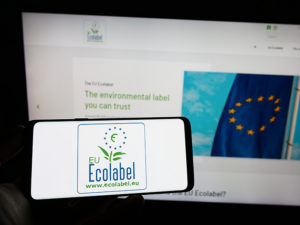More news
- Focus on architectural: Mastering colour consistency in architectural coatings
- BASF and University of California, Berkeley, celebrate their successful 10-year collaborat...
- Vattenfall and BASF sign purchase agreement for 49% of Germany’s Nordlicht offshore wind...
- Covestro introduces polycarbonates from recycled, attributed materials for high purity app...
- Pili has successfully industrialised a bio-based aniline derivative to decarbonise the che...

Consumers worldwide increasingly seek out climate and environmentally friendly products, including paints, and industry is meeting this demand with a range of more sustainable products that they flag with green claims, such as carbon neutral or zero organic compounds. However, paint makers need to ensure they can prove those claims because regulators are cracking down on greenwashing. Sara Lewis reports from Brussels
The March 22 proposal for a European Union (EU) ‘green claims directive’ [1], currently before EU legislators, seeks to prevent greenwashing in the 27-country bloc by requiring prior certification and approval of both green claims and eco-labelling by accredited independent bodies.
“If you want to use green claims you will have to prove it,” EU environment Commissioner Virginijus Sinkevičius said, when unveiling the proposal. Sinkevičius complained that currently it was “extremely difficult to separate the truth from fiction” in sustainability-focused marketing, highlighting a 2020 European Commission study [2] that found 53.3% of environmental claims in the EU were vague, misleading or unfounded.
Assuming the proposed law is approved, national regulators would henceforth check green claims on the market comply, making findings public and fining those guilty of greenwashing, because “we want that the proposal has teeth,” said Sinkevičius. Under this legislation, consumer groups could also bring collective legal action against companies they suspect of greenwashing.
To stop what Sinkevičius said was a “proliferation” of green labels, the proposal sets up a registry of acceptable labels that meet minimum transparency rules, including the EU’s own ecolabel scheme, which also complies with the green claim requirements.
“If a product already has an EU ecolabel it can comply with the green claims directive to some extent,” Karthik Kumar, Sustainability Officer of the European Council of the Paint, Printing Ink and Artists’ Colours Industry (CEPE) told PPCJ, noting that indoor and outdoor paint already has an EU ecolabel [3]. Through a pilot project, CEPE was also pivotal in developing a product environmental footprint (PEF) methodology for verifying lifecycle assessments of decorative paints [4] that has formal EU recognition, so could be used as one of the methods to substantiate claims.

READ MORE:
EU regulations round-up: September 2023 – Sustainability reporting standards loom
Reintroducing the wheel: Linseed paint as the natural option
Creating confusion and other concerns
But it was not all good news, as Kumar said that CEPE is concerned that under the proposal “if the product contains any substances of concern, you are not allowed to make a claim” of environmental good practice, rather than setting a threshold for volume content of such materials, as does the paints ecolabel. CEPE contends that this generic hazard-based approach ignores the fact substances might be critical for product sustainability and warns that the current wording would mean even an ecolabelled product containing a hazardous substance could not bear green claims. CEPE is calling for a risk-based approach.
Another concern is the costs and administrative burden linked to the certificate of conformity that member states would issue for green claims and labelling, especially for SMEs (small-and-medium-sized enterprises). Moreover, since the directive allows governments to go further in setting national standards and there is no harmonised EU certificate, “it will create confusion in my opinion,” Kumar warned. The Commission, the EU’s executive, switched from a planned directly binding regulation that would have set the same standards EU-wide, to this directive to allow for differing national systems, but Kumar warned that this risked creating “lots of distortions” and “will be a challenge for industry.”
Kumar also saw overlap between the green claims directive and a proposed regulation [5] on the ecodesign of sustainable products (ESPR), which will require paints to have a digital product passport accessible via QR codes that shows their environmental impact.
UK tackles VOC-free claims
Meanwhile, in post-Brexit UK, the national watchdog the Advertising Standards Authority (ASA) published updated guidance on misleading environmental claims on June 23 [6] based on recent rulings, including a handful [7] involving paint companies. The paint firms were rapped for using vague terms such as ‘natural’, not considering the entire product lifecycle and suggesting their whole range was environmentally friendly rather than some items. Also, the UK Competition and Markets Authority (CMA) has released guidance on making environmental claims on goods and services [8].
The British Coatings Federation (BCF) VOC Globe labelling system [9], which members use under licence, “is widely adopted”, with over 90% of paint sold in the UK using the globe system, David Park, BCF Public Affairs Manager told PPCJ. “We updated it recently to introduce a new ‘trace’ globe,” which measures trace amounts of VOCs that exist in all paints, because they contain solvents for <0.1% VOC content and then reissued the guidance to members, Park added [10].
BCF holds that ‘VOC-free’ and ‘Zero VOC’ are false claims, reflected in its April 2022 Green Claims Guide [11], which Park said, “is a relatively new initiative and was drawn up in consultation with members, so they have been involved in the process and agree with the contents”. Park highlights “the need for companies to compete on a level playing field and clear language on important topics like sustainability and environmental claims is a part of that process”.
But Park acknowledged that the Green Claims Guide “is a voluntary industry initiative, rather than a legal requirement, so we cannot give out any formal penalties. Most companies that we contact do adapt their marketing material to be in line with our guidance – it is often over-zealous marketing that causes problems, and there is often a technical knowledge gap that we can help to fill.”
And Park added that “whilst we don’t publicly name and shame non-compliance, we do have, and have used escalation routes to [local government regulators for] Trading Standards and the ASA and have discussed the issue with the CMA’s ‘Green Claims Team’”.
The BCF plans “to formally approach the ASA” to have them base decisions in the paint sector on the two guides in the coming months, “as we have a particular company’s claims we want to escalate,” Park said. “We’ve previously raised the ‘Zero VOC’ question with them, and I think the new ‘Trace’ globe will really help clarify things in this area,” he said.

Copyright BCF
READ MORE:
View from the UK: Chemicals and careers take centre stage
View from the US: Don’t look now, but PFAS is EVERYWHERE!
Across the Atlantic
Over the Atlantic, the American Coatings Association (ACA) also offers its USA members guidance compliance with the Federal Trade Commission (FTC) Act’s section 5 on misleading claims. “The guidance is based on publicly available information in FTC’s Green Guides, the FTC Act and enforcement cases,” Riaz Zaman, ASA Senior Counsel, Government Affairs told PPCJ.
The FTC’s consultation on an update to its Green Claims Guide, which aids compliance with section 5, closed April 24 with Zaman explaining that “FTC is at the beginning of a process that will take several years to complete”. The ACA’s submission [12] backs the FTC’s existing approach of offering general parameters without being overly prescriptive in non-binding administrative guidance rather than a regulatory obligation. Binding regulations are unlikely, because the current approach works and the aim is not to punish people, according to the FTC.
Nevertheless, the FTC has taken action against paint firms for greenwashing in the past and can fine businesses up to US$40,654 for each violation of an initial consent order to stop making the offending claims. In 2017, for example [13], the FTC settled with four companies over their zero-VOC claims.
With regulation and market demand both requiring more transparency and honesty in sustainability marketing, the pressure to avoid greenwashing will only grow on the global paint and coatings sector.
References
1 – https://eur-lex.europa.eu/legal-content/EN/TXT/?uri=COM%3A2023%3A0166%3AFIN
2 – https://eur-lex.europa.eu/legal-content/EN/TXT/PDF/?uri=CELEX:52022SC0085
3 – https://ec.europa.eu/environment/ecolabel/documents/paints.pdf and https://eur-lex.europa.eu/legal-content/EN/TXT/?uri=CELEX%3A02014D0312-20220718
5 – https://environment.ec.europa.eu/publications/proposal-ecodesign-sustainable-products-regulation_en
7 – https://www.asa.org.uk/rulings/edward-bulmer-ltd-a18-470596.html; https://www.asa.org.uk/rulings/technical-specialities-ltd-a19-1032603-technical-specialities-ltd.html; https://www.asa.org.uk/rulings/little-knights-ltd-G18-1017615.html; and https://www.asa.org.uk/rulings/celtic-sustainables-ltd-a18-467489.html
9 – https://coatings.org.uk/page/ReducingSolventsInPaint
10 – The Globe Label categories are now: ‘TRACE’ = VOC CONTENT <0.1%; ‘MINIMAL’ = VOC CONTENT 0.1 – 0.29%; ‘LOW’ = VOC CONTENT 0.30 – 7.99%; ‘MEDIUM’ = VOC CONTENT 8 – 24.99%; ‘HIGH’ = VOC CONTENT 25 – 50%; and ‘VERY HIGH’ = VOC CONTENT more than 50% – each category has its own Globe label
11 – https://coatings.org.uk/page/GreenClaims
12 – https://www.paint.org/wp-content/uploads/2023/05/FTC-comments-april-2023.pdf







